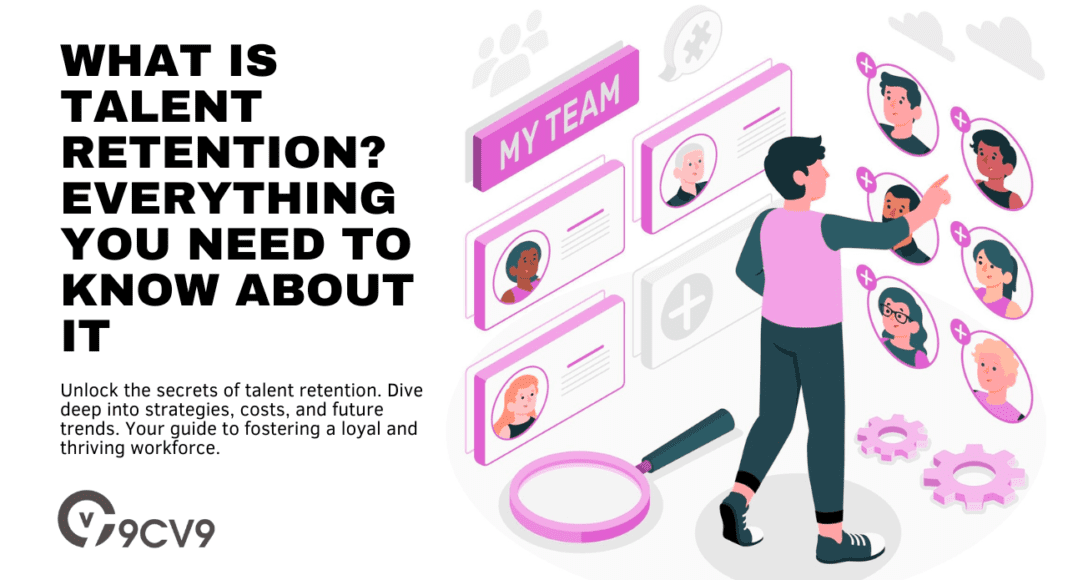Key Takeaways
- Uncover the hidden costs of turnover and learn how to mitigate them, ensuring a stable financial foundation for your organization.
- Explore HR’s pivotal role in shaping employee engagement and proactively implementing retention policies for long-term organizational success.
- Stay ahead of the curve with insights into future trends, from embracing remote work to leveraging advanced HR technology for effective talent retention strategies.
In today’s fiercely competitive job market, where the war for top talent rages on, organizations are increasingly recognizing the pivotal role of talent retention in sustaining long-term success.
As the heartbeat of an organization, employees form the backbone of its operations, and the cost of losing valuable talent extends far beyond the mere act of recruitment.
This comprehensive guide aims to unravel the intricacies of talent retention, providing you with everything you need to know about fostering a workplace environment that not only attracts top-tier professionals but keeps them engaged and committed for the long haul.
Defining Talent Retention: Navigating the Landscape of Employee Loyalty
At its core, talent retention is more than just a buzzword—it’s a strategic imperative.
But what does it truly mean in the context of a dynamic and ever-evolving workforce?
To embark on this exploration, we’ll dissect the very essence of talent retention, delving into its multifaceted dimensions.
From the traditional perspectives of employee satisfaction to the modern intricacies of holistic well-being, we’ll define talent retention in a way that resonates with the pulse of contemporary organizational dynamics.
The Staggering Costs of Turnover: Beyond the Balance Sheet
The financial implications of employee turnover extend well beyond the numbers on a balance sheet.
In this section, we’ll uncover the hidden costs that often elude the scrutiny of conventional accounting practices.
From the tangible expenses associated with recruitment and onboarding to the intangible toll on workplace morale and productivity, we’ll paint a comprehensive picture of why talent retention is not just a desirable objective but an economic necessity.
Strategies for Effective Talent Retention: Crafting a Blueprint for Success
Armed with the understanding of why talent retention is crucial, we’ll transition into the practical realm.
What strategies can organizations employ to retain their most valuable assets?
This section serves as a treasure trove of insights, exploring the nuances of competitive compensation structures, the allure of career development initiatives, the impact of a positive work environment, and the motivational power of recognition and rewards programs.
The Role of HR in Talent Retention: Orchestrating Employee Engagement
Human Resources (HR) stands at the forefront of talent retention efforts, wielding significant influence over the employee experience.
In this segment, we’ll unravel the ways in which HR professionals can actively shape and mold retention policies. From fostering a culture of open communication to leveraging cutting-edge HR technologies, we’ll explore the multifaceted role of HR in building an engaged and loyal workforce.
Embark on a journey with us as we traverse the realms of talent retention, exploring its intricacies, unraveling its challenges, and providing you with the tools to transform your organization into a talent magnet.
This isn’t just a guide; it’s your roadmap to understanding and mastering the dynamic landscape of talent retention.
Stay tuned as we navigate through the past, present, and future of employee loyalty, leaving no stone unturned in our quest to uncover “What is Talent Retention? Everything You Need To Know About It.”
Before we venture further into this article, we like to share who we are and what we do.
About 9cv9
9cv9 is a business tech startup based in Singapore and Asia with a strong presence all over the world.
With over seven years of startup and business experience, and being highly involved in connecting with thousands of companies and startups, the 9cv9 team has listed some important learning points in this overview of What is Talent Retention and Everything You Need To Know About It.
If your company needs recruitment and headhunting services to hire top employees, you can use 9cv9 headhunting and recruitment services to hire top talents and candidates. Find out more here, or send over an email to [email protected].
Or just post 1 free job posting here at 9cv9 Hiring Portal in under 10 minutes.
What is Talent Retention? Everything You Need To Know About It
- The Cost of Employee Turnover
- Strategies for Effective Talent Retention
- Role of HR in Talent Retention
- Future Trends in Talent Retention
1. The Cost of Employee Turnover
The Financial Toll: Unraveling the Monetary Implications
- Direct Recruitment Costs:
- Traditional recruitment processes demand substantial financial investments, encompassing job postings, candidate screening, and interview expenses. These costs accumulate each time an employee leaves, amplifying the burden on organizational budgets.
- Onboarding Expenditure:
- The onboarding phase incurs considerable expenses in terms of training, orientation, and provision of necessary resources. Employee turnover forces organizations to repeat this process, compounding the financial strain.
- Productivity Dips and the Bottom Line:
- When an employee departs, there’s a transitional period during which productivity is inherently compromised. This can translate into missed deadlines, disrupted projects, and ultimately, a hit to the organization’s bottom line.

Hidden Costs: Beyond the Balance Sheet
- Impact on Team Morale:
- The departure of a colleague can negatively influence team morale, leading to decreased motivation and collaboration. This intangible cost affects the overall workplace atmosphere, potentially contributing to a culture of uncertainty and instability.
- Knowledge Drain:
- Each departing employee takes with them a wealth of institutional knowledge and experience. Replacing this intellectual capital requires additional investments in training and knowledge transfer, impacting the efficiency of the organization.
Quantifying the Intangibles: The True Cost of Employee Turnover
- Employee Engagement and Client Relationships:
- High turnover can erode the bonds formed with clients. Frequent changes in account managers or customer-facing roles can lead to dissatisfaction among clients, impacting revenue streams and hindering business growth.
- Innovation and Creativity Stifled:
- A stable workforce fosters a culture of innovation and creativity. High turnover disrupts this equilibrium, stifling the flow of fresh ideas and hindering the organization’s ability to adapt to market trends.
- Employee Burnout and Increased Absenteeism:
- A continuous cycle of turnover places additional burdens on existing employees, potentially leading to burnout and increased absenteeism. This snowball effect compounds organizational challenges, exacerbating the overall impact on productivity.
The Long-term Perspective: Sustaining Organizational Growth
- Building a Resilient Workforce:
- By understanding and mitigating the financial and intangible costs associated with turnover, organizations can invest in strategies that foster a resilient workforce. This includes robust retention programs, continuous employee development, and proactive measures to address workplace concerns.
- Strategic Talent Management:
- Recognizing turnover as a strategic challenge allows organizations to implement long-term talent management strategies. This involves creating an inclusive work environment, offering career advancement opportunities, and establishing a feedback loop to address employee concerns before they escalate.
The cost of employee turnover extends far beyond the immediate financial impact.
It permeates the organizational fabric, affecting team dynamics, innovation, and client relationships.
By delving into these intricacies and learning from real-world examples, organizations can formulate comprehensive strategies to minimize turnover and ensure sustained growth.
2. Strategies for Effective Talent Retention
Competitive Compensation and Benefits: Beyond the Salary
- Salary Benchmarking:
- Regularly assess and benchmark salaries against industry standards to ensure competitiveness. Use market data to adjust compensation structures and retain top talent.
- Comprehensive Benefits Packages:
- Offer attractive benefits beyond basic health insurance, such as wellness programs, flexible work arrangements, and unique perks. Tailoring benefits to the needs of diverse employees enhances overall job satisfaction.
- Example: Leading Tech Company’s Compensation Strategy:
- A renowned tech company revamped its compensation strategy by incorporating employee stock options, flexible work hours, and comprehensive health and wellness programs. This not only retained existing talent but also positioned the company as an employer of choice.

Career Development Opportunities: Nurturing Growth Within
- Individualized Development Plans:
- Collaborate with employees to create personalized development plans. This involves identifying career goals, providing training opportunities, and mentoring to foster professional growth.
- Promotion Pathways:
- Clearly define pathways for career progression within the organization. Employees are more likely to stay when they see a future where their skills are valued and their career aspirations are supported.
- Example: Global Consulting Firm’s Career Development Model:
- A global consulting firm implemented a structured career development model that included mentorship programs, continuous learning opportunities, and a transparent promotion process. This approach significantly reduced turnover among mid-level employees.

Positive Work Environment: Cultivating Employee Well-being
- Open Communication Channels:
- Establish open lines of communication to encourage employees to voice their concerns and ideas. A transparent and inclusive environment fosters trust and a sense of belonging.
- Work-Life Balance Initiatives:
- Implement initiatives that support a healthy work-life balance, such as flexible work hours, remote work options, and policies that discourage overtime. A balanced lifestyle contributes to employee satisfaction and retention.
- Example: Innovative Startup’s Work Environment Initiatives:
- An innovative startup introduced a “no-email after 6 pm” policy and flexible work schedules. This not only improved the work-life balance for employees but also created a positive work culture that attracted and retained top talent.

Recognition and Rewards Programs: Acknowledging Contributions
- Regular Recognition Programs:
- Establish programs to recognize and reward outstanding performance. This can include employee of the month awards, spot bonuses, or public acknowledgment of achievements.
- Non-Monetary Incentives:
- Explore non-monetary incentives such as professional development opportunities, extra vacation days, or exclusive access to company events. These perks contribute to a positive workplace culture.
- Example: Retail Giant’s Recognition Program Success:
- A leading retail company implemented a peer-to-peer recognition program where employees could nominate colleagues for exceptional contributions. The program not only boosted morale but also played a significant role in talent retention.
Utilizing HR Technology for Retention: Leveraging Innovation
- Employee Engagement Platforms:
- Invest in HR technology platforms that facilitate employee engagement, feedback, and performance tracking. These tools provide insights into employee satisfaction and allow for targeted interventions.
- Predictive Analytics for Turnover:
- Implement predictive analytics to identify potential turnover risks. By analyzing patterns and trends, HR teams can proactively address issues before they escalate.
- Example: Tech-Savvy Company’s HR Tech Integration:
- A technology-driven company integrated a comprehensive HR analytics platform that not only tracked employee engagement but also used predictive analytics to identify departments at higher risk of turnover. This proactive approach significantly reduced attrition rates.
Effective talent retention strategies require a holistic approach that goes beyond monetary compensation.
By focusing on career development, cultivating a positive work environment, implementing recognition programs, and leveraging HR technology, organizations can create an environment where employees feel valued and are motivated to stay for the long term.
Learning from successful examples showcases the real-world impact of these strategies on talent retention.
3. Role of HR in Talent Retention
HR’s Strategic Influence: Shaping Employee Engagement
- Creating a Culture of Engagement:
- Establish and promote a culture that prioritizes employee engagement. HR plays a pivotal role in fostering a positive workplace environment where employees feel valued, heard, and connected to the organization’s mission.
- Surveys and Feedback Mechanisms:
- Implement regular surveys and feedback mechanisms to gauge employee satisfaction and identify areas for improvement. HR can leverage data-driven insights to tailor retention strategies to specific needs.
- Example: Global Corporation’s Employee Engagement Initiative:
- A multinational corporation initiated regular pulse surveys to measure employee engagement. By analyzing the feedback, HR implemented targeted programs, such as wellness initiatives and team-building activities, resulting in a noticeable increase in overall job satisfaction and retention rates.
Proactive Retention Policies: Navigating Employee Challenges
- Identifying Flight Risks:
- Utilize data analytics and employee feedback to identify potential flight risks within the organization. HR teams can proactively address concerns before they escalate, preventing valuable talent from seeking opportunities elsewhere.
- Retention Interviews:
- Conduct retention interviews to understand the factors influencing an employee’s decision to stay or leave. This qualitative approach allows HR to gather valuable insights and tailor retention strategies to individual needs.
- Example: Innovative Tech Firm’s Retention Interview Program:
- A forward-thinking tech company implemented a retention interview program, where HR conducted confidential one-on-one sessions with employees considering leaving. This approach led to the implementation of targeted retention initiatives, reducing turnover among key teams.
Leveraging HR Technology for Retention Success
- Employee Relationship Management (ERM) Systems:
- Implement ERM systems that consolidate employee data, allowing HR professionals to track employee interactions, identify trends, and tailor retention strategies based on individual and team needs.
- Predictive Analytics for Attrition:
- Harness the power of predictive analytics to forecast potential attrition risks. By analyzing historical data and identifying patterns, HR can take proactive measures to retain critical talent.
- Example: HR Tech Integration at Global Financial Institution:
- A leading financial institution integrated advanced HR technology that included ERM systems and predictive analytics. This allowed HR to identify and address retention risks early, resulting in a significant reduction in turnover rates.
Employee Development Initiatives: Nurturing Growth Within
- Training and Skill Development:
- Collaborate with department heads to design and implement training programs that enhance employees’ skills. Providing opportunities for professional growth demonstrates a commitment to employees’ long-term success.
- Succession Planning:
- Engage in strategic succession planning to ensure a pipeline of internal talent for key roles. HR can identify high-potential employees and cultivate their skills for future leadership positions.
- Example: Pharma Company’s Succession Planning Success:
- A pharmaceutical company implemented a comprehensive succession planning program, identifying and grooming internal talent for leadership roles. This proactive approach not only reduced external hires but also contributed to employee satisfaction and retention.
Utilizing Employee Feedback for Continuous Improvement
- Regular Check-ins and Stay Interviews:
- Conduct regular check-ins and stay interviews to understand employees’ evolving needs and aspirations. This ongoing dialogue allows HR to adapt retention strategies to changing circumstances.
- Feedback Loops and Action Plans:
- Establish feedback loops where HR actively communicates the results of employee feedback surveys and implements action plans based on the identified areas for improvement.
- Example: HR-Led Feedback Initiatives at Tech Startup:
- A dynamic tech startup implemented a continuous feedback loop facilitated by HR, ensuring that employee concerns were addressed promptly. This approach not only strengthened employee engagement but also contributed to the company’s reputation as an employer of choice.
In summary, the role of HR in talent retention extends beyond administrative functions to strategic leadership in creating a culture of engagement, implementing proactive retention policies, leveraging HR technology, fostering employee development, and utilizing continuous feedback for improvement.
Learning from successful examples highlights the tangible impact HR can have on retaining valuable talent within the organization.
4. Future Trends in Talent Retention
Evolving Landscape: Anticipating Future Trends in Talent Retention
- Introduction to Future Trends:
- As the workforce landscape continues to undergo rapid transformations, staying ahead of emerging trends is critical for organizations aiming to retain top talent. Explore the following key areas where the future of talent retention is likely to evolve.
Embracing Remote Work Realities: The Hybrid Model
- Hybrid Work Environments:
- The rise of remote work has reshaped expectations. Adopting a hybrid work model that combines in-office and remote work options will become integral to attracting and retaining talent.
- Flexible Scheduling and Work-Life Integration:
- Future trends suggest a shift towards more flexible scheduling, allowing employees to better integrate work into their lives. This approach acknowledges the importance of work-life balance in talent retention.
- Example: Tech Giant’s Hybrid Work Success:
- A leading technology company successfully implemented a hybrid work model, offering flexibility in work arrangements. This not only attracted diverse talent but also contributed to improved job satisfaction and retention rates.

Technological Advancements in HR: The Rise of AI and Analytics
- AI in Recruitment and Retention:
- Artificial intelligence (AI) will play a more significant role in talent retention by analyzing employee data to identify patterns, predict turnover risks, and suggest personalized retention strategies.
- Advanced Analytics for Employee Insights:
- HR analytics will evolve, providing deeper insights into employee behavior, engagement levels, and career aspirations. This data-driven approach will enable more targeted and effective retention initiatives.
- Example: AI-Driven Retention Solutions in Global Corporation:
- A multinational corporation integrated AI-driven retention solutions into its HR systems. The technology accurately predicted turnover risks, allowing HR to implement preemptive measures and significantly reduce employee attrition.
Focus on Employee Well-being: A Holistic Approach
- Well-being Programs Beyond Physical Health:
- Future trends indicate an expansion of well-being programs to address not only physical health but also mental health, stress management, and overall employee happiness.
- Holistic Benefits Packages:
- Organizations will prioritize comprehensive benefits packages that go beyond traditional offerings, including mental health support, financial wellness programs, and initiatives promoting a healthy work-life balance.
- Example: Progressive Wellness Initiatives at Innovative Startups:
- Forward-thinking startups are leading the way with holistic wellness initiatives, offering mindfulness sessions, counseling services, and flexible schedules. These initiatives contribute to a positive work environment and enhance talent retention.
Diversity, Equity, and Inclusion (DEI) Initiatives
- Emphasis on Diversity and Inclusion:
- Future talent retention strategies will increasingly focus on creating diverse and inclusive workplaces. Organizations will actively promote diversity in hiring and create inclusive cultures to retain a broader spectrum of talent.
- Equity in Opportunities and Advancement:
- Addressing issues related to pay equity, opportunities for advancement, and equal access to career development will be crucial for organizations committed to talent retention.
- Example: Global Company’s DEI Success Story:
- A multinational corporation revamped its talent retention strategy by placing a strong emphasis on diversity and inclusion. This resulted in a more inclusive workplace, attracting a diverse pool of talent and significantly reducing turnover among underrepresented groups.
Adaptation to Changing Employee Expectations
- Personalized Career Paths:
- Recognizing that one-size-fits-all career paths are no longer effective, future talent retention strategies will involve creating personalized career development plans tailored to individual employee aspirations.
- Continuous Learning and Skill Development:
- Employees expect continuous learning opportunities. Future-focused organizations will invest in ongoing skill development programs to keep employees engaged and enhance their value within the organization.
- Example: Tech Startup’s Adaptive Career Development Model:
- An innovative tech startup implemented an adaptive career development model, allowing employees to customize their career paths. This approach not only increased job satisfaction but also contributed to talent retention by aligning individual goals with organizational objectives.
Environmental and Social Responsibility
- Corporate Social Responsibility (CSR) Initiatives:
- Organizations will place greater emphasis on environmental and social responsibility, aligning their values with those of their employees. CSR initiatives will become a factor in talent attraction and retention.
- Ethical Practices in Business Operations:
- Employees are increasingly drawn to organizations with ethical business practices. Talent retention strategies will involve showcasing a commitment to sustainability, ethical sourcing, and social impact.
- Example: Sustainable Practices in Retail Giant’s Talent Retention:
- A major retail corporation adopted sustainable business practices, including eco-friendly initiatives and ethical sourcing. This commitment resonated with employees, contributing to a positive corporate culture and enhancing talent retention.
In a rapidly evolving work landscape, anticipating and adapting to future trends in talent retention is crucial for organizational success.
Embracing hybrid work models, leveraging advanced HR technologies, prioritizing employee well-being, championing diversity and inclusion, adapting to changing expectations, and embracing environmental and social responsibility are key components of a future-ready talent retention strategy.
By staying attuned to these trends, organizations can foster a workplace that not only attracts top talent but also retains it for the long term.
Conclusion
In the dynamic landscape of modern workplaces, where the war for top talent rages on, talent retention emerges as the linchpin for organizational success.
This comprehensive guide has delved into the intricate facets of talent retention, providing an exhaustive exploration of what it is and everything you need to know about it.
From the financial ramifications of employee turnover to the strategic influence of HR, and from the tried-and-true strategies for retention to the future trends shaping the talent retention landscape, we’ve journeyed through the critical elements that define and refine the art of retaining valuable talent.
Unraveling the Financial Tapestry: The True Cost of Employee Turnover
We began our exploration by dissecting the financial implications of employee turnover.
The direct recruitment costs, onboarding expenditures, and the nuanced impact on team morale and knowledge drain all contribute to a staggering tapestry of hidden costs that extend far beyond the balance sheet.
Crafting Strategies for Today and Tomorrow: Effective Talent Retention Approaches
Moving forward, we navigated the landscape of effective talent retention strategies.
Competitive compensation and benefits, career development opportunities, cultivating positive work environments, and robust recognition and rewards programs formed the pillars of a holistic approach. Real-life case studies showcased the transformative power of these strategies, underlining their efficacy in retaining valuable talent.
HR’s Crucial Role: Orchestrating Employee Engagement and Retention
The spotlight then shifted to the indispensable role of Human Resources (HR) in talent retention.
From creating a culture of engagement to implementing proactive retention policies and leveraging cutting-edge HR technology, HR emerged as a strategic force in shaping the employee experience.
Learning from real-world examples illustrated how forward-thinking organizations leverage HR’s influence to retain their most valuable assets.
Peering into the Future: Anticipating Trends in Talent Retention
As we gazed into the crystal ball of the future, we explored emerging trends set to redefine talent retention.
The embrace of hybrid work models, the integration of artificial intelligence and advanced analytics in HR, a heightened focus on employee well-being, diversity, equity, and inclusion initiatives, adaptation to changing employee expectations, and the commitment to environmental and social responsibility collectively paint a portrait of the future-ready organization.
Concluding Thoughts: A Call to Action for Talent Retention Excellence
In conclusion, talent retention is not merely a reactive strategy; it’s a proactive, strategic imperative for organizations seeking sustained success.
It’s an ongoing commitment to creating environments where employees thrive, grow, and feel a genuine sense of belonging.
As we conclude this extensive exploration, the call to action is clear: organizations must embrace the multifaceted nature of talent retention, constantly evolve their strategies, and stay attuned to the ever-changing expectations of the workforce.
Whether you’re an HR professional, a business leader, or an employee aspiring for a fulfilling career journey, the insights shared in this guide serve as a compass, guiding you through the intricate maze of talent retention.
In the competitive realm of the modern workforce, the organizations that master the art of talent retention are not just employers—they are architects of exceptional employee experiences, custodians of workplace harmony, and champions of sustained success.
As the journey continues, let the principles and strategies explored here be your steadfast companions, guiding you toward a future where talent retention isn’t just a goal; it’s a testament to your organization’s enduring excellence.
If your company needs HR, hiring, or corporate services, you can use 9cv9 hiring and recruitment services. Book a consultation slot here, or send over an email to [email protected].
If you find this article useful, why not share it with your hiring manager and C-level suite friends and also leave a nice comment below?
We, at the 9cv9 Research Team, strive to bring the latest and most meaningful data, guides, and statistics to your doorstep.
To get access to top-quality guides, click over to 9cv9 Blog.
People Also Ask
What is the meaning of retaining talent?
Retaining talent refers to the strategic efforts an organization takes to keep skilled and valuable employees within its workforce. It involves creating an environment where employees feel engaged, motivated, and satisfied, reducing turnover and fostering long-term commitment and loyalty.
How important is talent retention?
Talent retention is paramount for organizational success. It reduces recruitment costs, maintains institutional knowledge, and enhances productivity. A loyal workforce contributes to a positive culture, innovation, and sustained competitiveness in the ever-evolving business landscape.
What is key talent retention?
Key talent retention refers to the strategic focus on retaining critical individuals crucial to an organization’s success. It involves identifying, nurturing, and implementing targeted initiatives to ensure the continued engagement and commitment of key employees, preventing their departure and preserving organizational expertise.































![Writing A Good CV [6 Tips To Improve Your CV] 6 Tips To Improve Your CV](https://blog.9cv9.com/wp-content/uploads/2020/06/2020-06-02-2-100x70.png)


